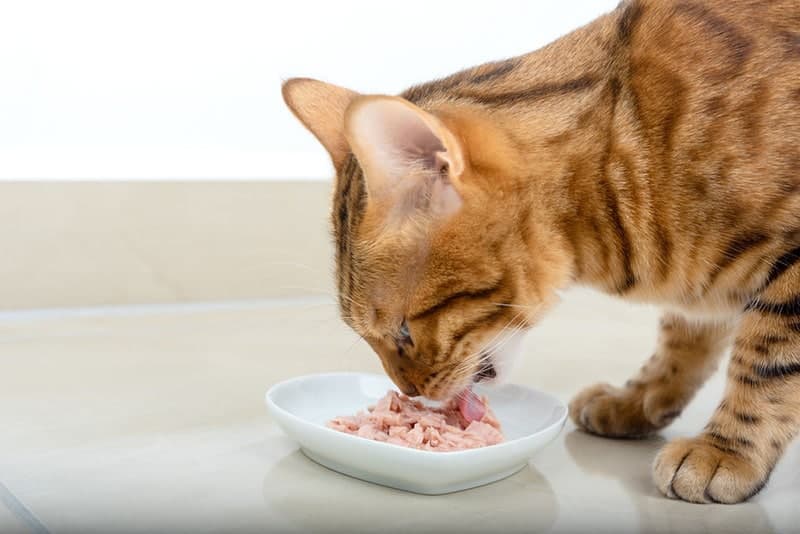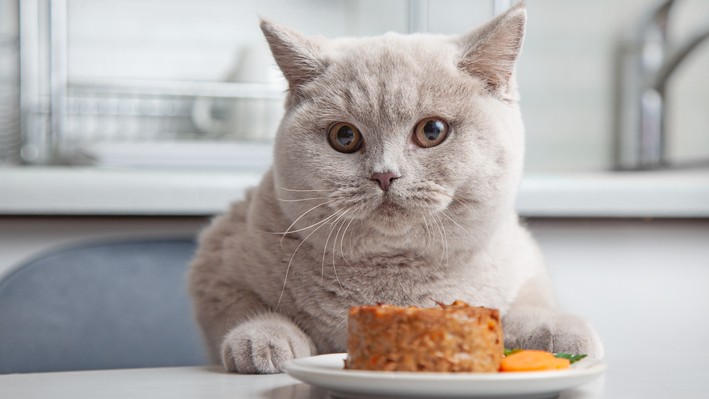Tuna in brine should be given to cats in moderation, if at all. While cats generally love the taste of tuna, it’s important to note that a diet excessively high in tuna can pose health risks for them.
The main concern with feeding cats too much tuna, especially tuna in brine, is the high levels of mercury it can contain. Mercury accumulation in a cat’s system over time can lead to mercury poisoning, causing neurological issues and other health problems.
Moreover, the high sodium content in brine can also be harmful to cats. Excessive salt intake can lead to dehydration, electrolyte imbalances, and other health complications.
If you want to give your cat tuna as a treat, opt for canned tuna in water and ensure it’s in small amounts and infrequent. It’s even better to choose specially formulated cat foods that are nutritionally balanced for their needs rather than relying on human food for their diet.
What is Tuna in Brine and How Does It Affect Cats?

Tuna in brine refers to canned tuna that has been packed in a solution of water and salt. While tuna can be a tasty treat for cats and many felines enjoy the taste, it’s important to be cautious about feeding them tuna regularly or in large quantities.
Cats are obligate carnivores, which means they primarily need a diet consisting of meat to meet their nutritional requirements. Tuna in brine is high in protein and contains beneficial nutrients like omega-3 fatty acids, which can be good for cats in moderation.
However, there are a few considerations to keep in mind:
High Mercury Levels
Tuna, especially larger species like albacore tuna, can have high levels of mercury. Frequent consumption of tuna can lead to mercury poisoning in cats, which can cause various health issues, including neurological problems.
Nutritional Imbalance
Tuna lacks certain essential nutrients that are crucial for a cat’s diet. Feeding tuna exclusively or too frequently can lead to nutritional imbalances, particularly in taurine, an amino acid vital for a cat’s heart and eyesight.
Salt Content
Brine contains salt, and excessive salt intake can lead to dehydration and electrolyte imbalances in cats, potentially causing health problems like kidney issues or urinary tract problems.
Addiction and Dietary Issues
Cats may become overly fond of tuna, leading them to reject other foods. This can result in dietary issues if they don’t get a balanced diet, potentially leading to malnutrition.
Given these concerns, it’s best to offer tuna to your cat as an occasional treat in small amounts and opt for tuna packed in water instead of brine to reduce the salt content. It’s important to ensure that your cat’s primary diet consists of high-quality cat food specifically formulated to meet their nutritional needs.
How Does Tuna in Brine Impact a Cat’s Health?
Feeding tuna in brine to cats can have both positive and negative impacts on their health, depending on the frequency and quantity consumed:
Positive aspects
- Protein Source: Tuna is a good source of protein for cats. Protein is essential for their muscle growth, tissue repair, and overall health.
- Omega-3 Fatty Acids: Tuna contains omega-3 fatty acids, which can benefit a cat’s coat, skin, and potentially provide some anti-inflammatory properties.
Negative aspects
- Mercury Poisoning: Tuna, especially larger species, can contain high levels of mercury. Frequent consumption of tuna, especially in brine, can lead to mercury poisoning in cats, resulting in neurological issues and other health complications.
- Nutritional Imbalance: Tuna lacks certain essential nutrients like taurine, which is crucial for a cat’s heart health and eyesight. Feeding too much tuna can lead to nutritional imbalances and deficiencies.
- Salt Content: Brine contains salt, and excessive salt intake can lead to dehydration, electrolyte imbalances, kidney problems, and urinary tract issues in cats.
- Dependency and Dietary Issues: Cats may develop a strong preference or addiction to tuna, leading them to refuse other foods. This can result in dietary issues, malnutrition, and an unbalanced diet if they don’t consume a variety of nutritionally complete cat foods.
Given these potential health impacts, it’s essential to offer tuna in brine to cats as an occasional treat in small amounts. It’s preferable to choose tuna packed in water to reduce the salt content. Cats should primarily consume high-quality cat food specifically formulated to meet their nutritional requirements.
What are Safe Portions and Alternatives of Tuna for Cats?

Safe portions of tuna for cats as an occasional treat should be small and infrequent, ideally a teaspoon-sized portion of canned tuna. However, it’s crucial to avoid making tuna a regular part of their diet due to potential risks associated with mercury content, salt, and nutritional imbalances. Instead, consider alternatives such as small amounts of cooked fish like salmon or mackerel, ensuring it’s boneless and without seasoning or additives.
Opt for cat-specific treats or foods formulated with protein sources meeting feline nutritional needs, like chicken or turkey. Various commercial cat treats are available, specially designed to provide essential nutrients. Some cats may enjoy small portions of fruits or vegetables occasionally, but ensure these are safe for feline consumption.
Additionally, offering cat grass can be a safe and natural treat that aids digestion and provides enrichment. Always consult with a veterinarian for guidance on your cat’s diet and suitable treats to ensure their health and nutritional requirements are met without adverse effects.
FAQ’s
Can I feed my cat tuna everyday?
Feeding tuna to your cat every day isn’t advisable due to potential risks of mercury poisoning, nutritional imbalances, and salt content. It’s best offered occasionally as a treat.
Why do cats love tuna so much?
Cats are attracted to tuna due to its strong smell and taste, which can be appealing. However, their preference for tuna can lead to dependency and refusal of other foods if given excessively.
What can I feed my cat if I don’t have cat food?
In case of emergency, you can offer small amounts of cooked, unseasoned meats like chicken, turkey, or fish as a temporary alternative. However, it’s important to provide proper cat food for their complete nutritional needs.
What canned fish can cats eat?
Cats can eat certain canned fish like canned salmon or mackerel, but it’s crucial to ensure they are boneless and don’t contain any seasoning or additives. These should also be offered as occasional treats rather than regular meals.
Is tuna in water an okay substitute for wet cat food?
While tuna in water can be occasionally offered as a treat, it’s not an ideal substitute for wet cat food due to potential nutritional deficiencies and high mercury levels. Wet cat food is specifically formulated to meet a cat’s dietary requirements.
Can I give my cat canned chicken?
Yes, you can offer canned chicken to your cat as an occasional treat, provided it’s plain chicken without any added seasoning, sauces, or additives. However, it shouldn’t replace their regular balanced diet from cat food.
Final Words
It’s important to remember that while cats enjoy tuna, too much tuna in brine can be harmful to their health. Excessive salt and mercury in tuna pose risks like dehydration, electrolyte imbalances, and mercury poisoning in cats. Moderation is key when offering tuna as a treat.
Opt for cat-specific treats or balanced commercial cat food to ensure a well-rounded and safe diet for your furry friend. Always consult a veterinarian before introducing new foods to your cat’s diet to keep them healthy and happy.

